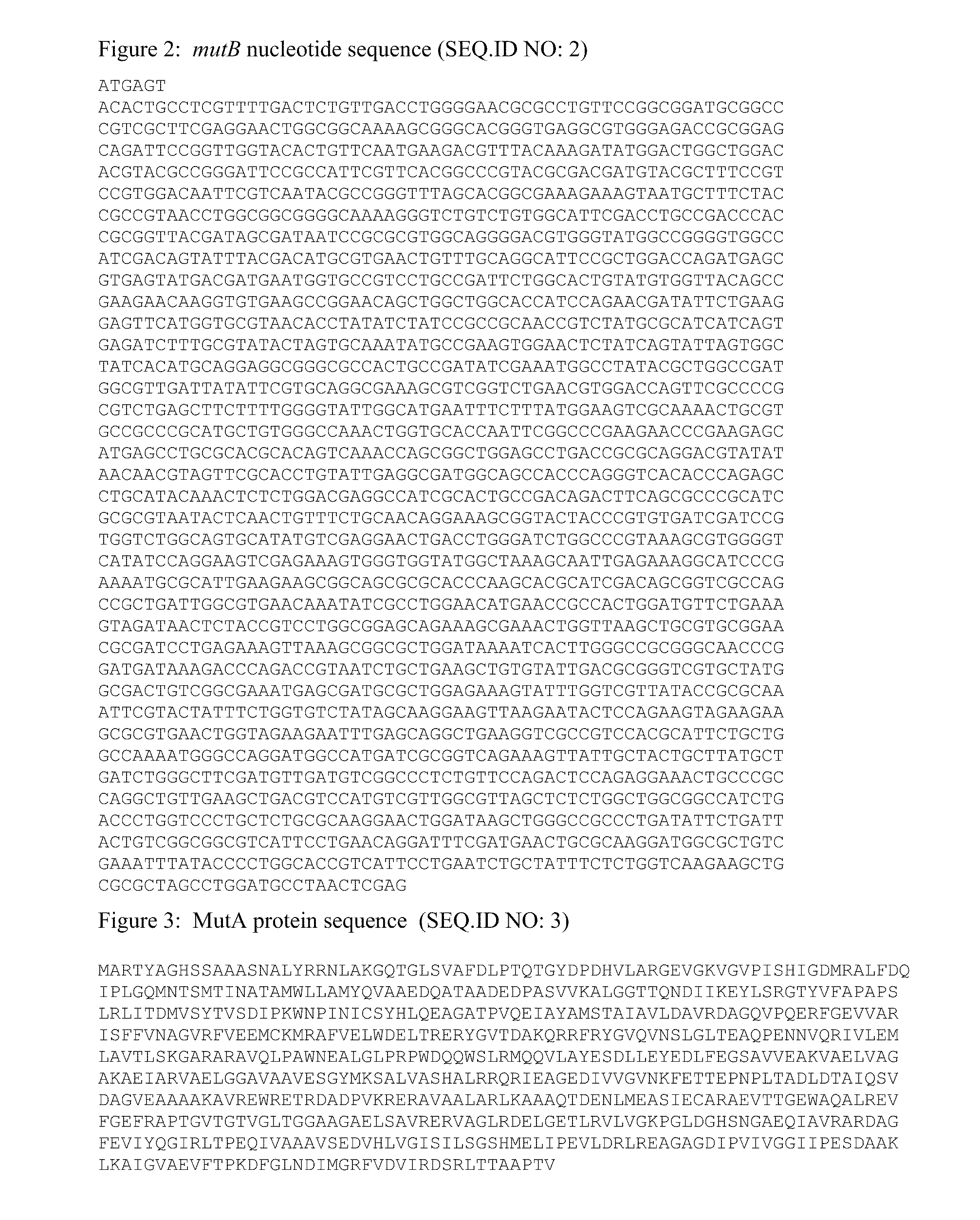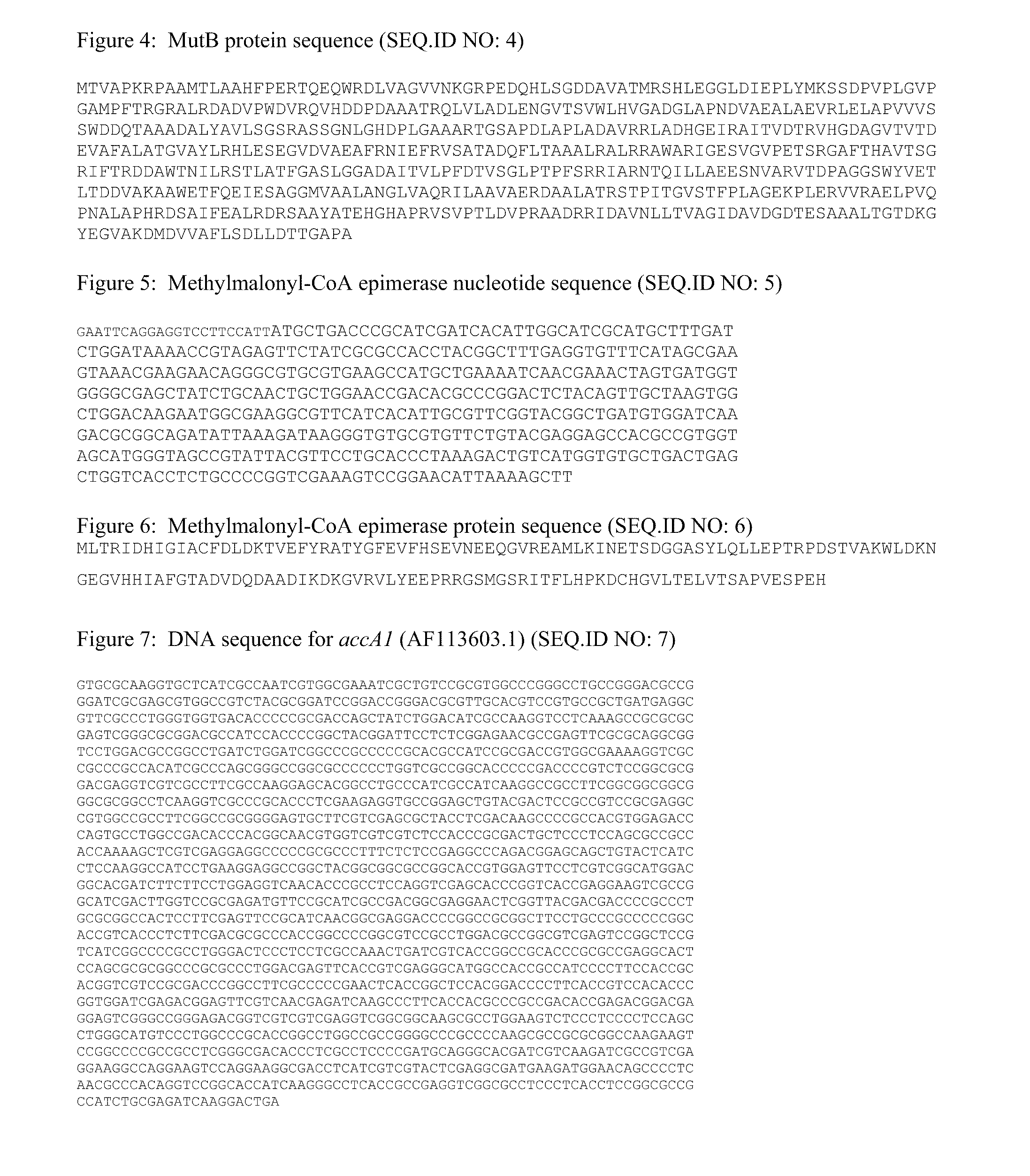Scattered Branched-Chain Fatty Acids And Biological Production Thereof
a technology of branched-chain fatty acids and biological production, which is applied in the direction of enzymology, ligases, transferases, etc., can solve the problems of not producing medium-chain branched-chain fatty acids, fatty acids may not be available or easily isolated from a natural organism in meaningful quantities,
- Summary
- Abstract
- Description
- Claims
- Application Information
AI Technical Summary
Problems solved by technology
Method used
Image
Examples
example 1
Construction of Methylmalonyl-CoA Mutase Expression Vector
There are numerous genes annotated to encode the two subunits of methylmalonyl-CoA mutase. Janibacter sp. HTCC2649 encodes two such genes. Synthetic versions of these genes were prepared, with the codon usage altered to match that used by many E. coli genes (i.e., the coding sequence was codon-optimized for expression in E. coli). By analogy to other methylmalonyl-CoA mutase genes, these synthetic genes were named mutA (SEQ ID NO: 1) and mutB (SEQ ID NO: 2), corresponding to the MutA (SEQ ID NO: 3) and MutB (SEQ ID NO: 4) protein subunits. In the synthetic DNA, an extra three base pairs were added (encoding an alanine residue immediately after the initiation methionine) in mutA to facilitate introduction of an NcoI site. An XhoI restriction site was also placed after the coding sequence of mutB for insertion into the pBAD vector (Invitrogen). The NcoI / XhoI fragment was cloned into pBAD.
example 2
Construction of Methylmalonyl-CoA Epimerase Expression Vector
There are numerous genes annotated to encode methylmalonyl-CoA mutase. One such gene is from Streptomyces sviceus. A synthetic gene can be constructed (SEQ ID NO: 5) using codon usage similar to E. coli genes and with EcoRI and Hind III sites flanking the coding region. An E. coli Shine-Dalgarno sequence can be added between the EcoRI site and the initiation codon for the epimerase gene. The predicted protein product is the same as the predicted protein product from the S. sviceus gene (SEQ ID NO: 6). The epimerase gene can be cloned into the pBAD-mutAB construct using the EcoRI and Hind III restriction sites (downstream of mutB) to form the pBAD-mutAB-epimerase gene plasmid. E. coli cultures can be grown at 27° C. after induction with arabinose and supplemented with hydroxycobalamin to achieve expression of functional methylmalonyl-CoA mutase and branched-chain fatty acid production.
example 3
Construction of Propionyl-CoA Carboxylase Expression Vector
Nucleotide sequences (SEQ ID NO: 7 and SEQ ID NO: 8) encoding the two propionyl-CoA carboxylase subunits AccA1 (GenBank Accession NO. AF113603.1; SEQ ID NO: 9) and PccB (GenBank Accession No. AF113605.1; SEQ ID NO: 10)), respectively, from the Streptomyces coelicolor A3(2) propionyl-CoA carboxylase (Rodriguez E., Gramajo H., Microbiology. 1999 November; 145:3109-19), were codon-optimized for E. coli expression. A gene construct for expressing propionyl-CoA carboxylase was constructed with the following elements sequentially 1) PLlac0-1 promoter and operator plus T7 gene10 ribosomal binding site (SEQ ID NO: 11); 2) optimized accA1 (SEQ ID NO: 12); 3) three restriction site sequences including BglII, NotI and XbaI and a T7 gene10 ribosome binding site (SEQ ID NO: 13); and 4) codon-optimized pccB (SEQ ID NO: 14). The synthesized DNA fragments were cloned into the XhoI and PstI sites of expression vector pZA31-MCS (Expressys, Ru...
PUM
| Property | Measurement | Unit |
|---|---|---|
| Tm | aaaaa | aaaaa |
| temperature | aaaaa | aaaaa |
| pH | aaaaa | aaaaa |
Abstract
Description
Claims
Application Information
 Login to View More
Login to View More - R&D
- Intellectual Property
- Life Sciences
- Materials
- Tech Scout
- Unparalleled Data Quality
- Higher Quality Content
- 60% Fewer Hallucinations
Browse by: Latest US Patents, China's latest patents, Technical Efficacy Thesaurus, Application Domain, Technology Topic, Popular Technical Reports.
© 2025 PatSnap. All rights reserved.Legal|Privacy policy|Modern Slavery Act Transparency Statement|Sitemap|About US| Contact US: help@patsnap.com



